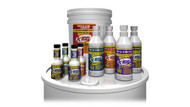Phase Separation and How K100 Burns Water Out of Fuel
By on Mar 13 2015
Is your car having a hard time turning over? Maybe your lawn mower or weed whacker —won't start. The problem could be water in your fuel tank. This is known as Fuel Phase Separation in ethanol-based fuel. As temperatures get warmer, snow, ice, and general condensation could find its way inside your tank and cause severe damage. Once this happens, you need a fuel additive, such as K100 Fuel Treatment, that can help clear it out. K100 works in both gasoline and diesel fuels to eliminate phase separation and to prevent it from happening in the future.
K100 is the best additive to use when storing both gasoline and diesel fuels.
Treating and Preventing Phase Separation
Using K100 will keep phase separation from happening at a .5% water concentration that usually causes phase separation at room temperatures in untreated E-10 (low level blend, 10% ethanol, 90% gasoline). Even if water levels continue to build beyond .5%, fuel treated with the recommended amount of K100 will still phase separate. Once treated, the fuel will burn the water contained inside with the help of K100.
It's important to note that the separation point can be raised by increasing the concentration of K100, but for most applications, the recommended mixing ratio is 1:300. If you are operating in a setting with very high moisture exposure, it is acceptable to increase this ratio to 1:200 or even 1:150.
Reversing phase separation does not require a complex chemical reaction. Rather, it is just a means of separating the water/ethanol mix so that the ethanol can return to the solution with the gasoline while the water is rendered unavailable to cause further chemical problems. Adding K100 to the phase separated fraction of the fuel will free the ethanol from the water. K100 then chemically reacts with the water to render it harmless while creating a burnable compound with specific gravity so that it can mix back into the E-10.
The key to reversing phase separation is making sure you use enough K100. According to K100's official website, they have found that it takes an amount of K100 equal to the phase separated fraction of the fuel you are treating in order to induce spontaneous phase separation reversal.
Determining How Much K100 To Use
The question then becomes, —How do I know how much the phase separated fraction is? " To determine this, figure out what the total fuel volume is and take 10% of that to get the ethanol content. You can figure an additional 1% for water content, even though phase separation will still happen at .5%. The amount that you have after doing the math is how much K100 you should add to the tank. You'll know you've done it right when the fuel begins to look clear. If it is still cloudy, add a little more K100.
When you break it down, phase separation reversal is not as cost-effective as prevention, and can also be a lot more frustrating. Suppose you had 100 ounces of phase separated fuel. Using the calculation above, it would take 11 ounces of K100 to reverse that and make the fuel usable again. If you treat the fuel beforehand with only a half-ounce of K100, phase separation will never even happen in the first place.
We hope that these treatment and prevention tips will assist you with any fuel phase separation problems you may be experiencing. K100 products can be used in a variety of applications ranging from vehicles to in-ground tanks, and more. If it runs on fuel, it needs K100; particularly if the weather is warming and the winter is waning. Be sure to keep in mind, too much will not hurt but too little will not help.
See for yourself how K100 helps burn water in the video below:
Head on over to Petroleum Service Company to save yourself some time, some money, and some fuel!
*Update: for more information on K100, you can check out this updated post.






